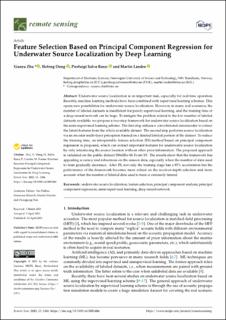| dc.contributor.author | Zhu, Xiaoyu | |
| dc.contributor.author | Dong, Hefeng | |
| dc.contributor.author | Salvo Rossi, Pierluigi | |
| dc.contributor.author | Landrø, Martin | |
| dc.date.accessioned | 2022-11-23T10:35:13Z | |
| dc.date.available | 2022-11-23T10:35:13Z | |
| dc.date.created | 2021-04-15T15:22:25Z | |
| dc.date.issued | 2021 | |
| dc.identifier.citation | Remote Sensing. 2021, 13 (8), . | en_US |
| dc.identifier.issn | 2072-4292 | |
| dc.identifier.uri | https://hdl.handle.net/11250/3033601 | |
| dc.description.abstract | Underwater source localization is an important task, especially for real-time operation. Recently, machine learning methods have been combined with supervised learning schemes. This opens new possibilities for underwater source localization. However, in many real scenarios, the number of labeled datasets is insufficient for purely supervised learning, and the training time of a deep neural network can be huge. To mitigate the problem related to the low number of labeled datasets available, we propose a two-step framework for underwater source localization based on the semi-supervised learning scheme. The first step utilizes a convolutional autoencoder to extract the latent features from the whole available dataset. The second step performs source localization via an encoder multi-layer perceptron trained on a limited labeled portion of the dataset. To reduce the training time, an interpretable feature selection (FS) method based on principal component regression is proposed, which can extract important features for underwater source localization by only introducing the source location without other prior information. The proposed approach is validated on the public dataset SWellEx-96 Event S5. The results show that the framework has appealing accuracy and robustness on the unseen data, especially when the number of data used to train gradually decreases. After FS, not only the training stage has a 95% acceleration but the performance of the framework becomes more robust on the receiver-depth selection and more accurate when the number of labeled data used to train is extremely limited. | en_US |
| dc.language.iso | eng | en_US |
| dc.publisher | MDPI | en_US |
| dc.rights | Navngivelse 4.0 Internasjonal | * |
| dc.rights.uri | http://creativecommons.org/licenses/by/4.0/deed.no | * |
| dc.title | Feature Selection Based on Principal Component Regression for Underwater Source Localization by Deep Learning | en_US |
| dc.title.alternative | Feature Selection Based on Principal Component Regression for Underwater Source Localization by Deep Learning | en_US |
| dc.type | Peer reviewed | en_US |
| dc.type | Journal article | en_US |
| dc.description.version | publishedVersion | en_US |
| dc.source.pagenumber | 16 | en_US |
| dc.source.volume | 13 | en_US |
| dc.source.journal | Remote Sensing | en_US |
| dc.source.issue | 8 | en_US |
| dc.identifier.doi | 10.3390/rs13081486 | |
| dc.identifier.cristin | 1904356 | |
| dc.relation.project | Norges forskningsråd: 294404 | en_US |
| dc.relation.project | Norges forskningsråd: 309960 | en_US |
| cristin.ispublished | true | |
| cristin.fulltext | original | |
| cristin.qualitycode | 1 | |

